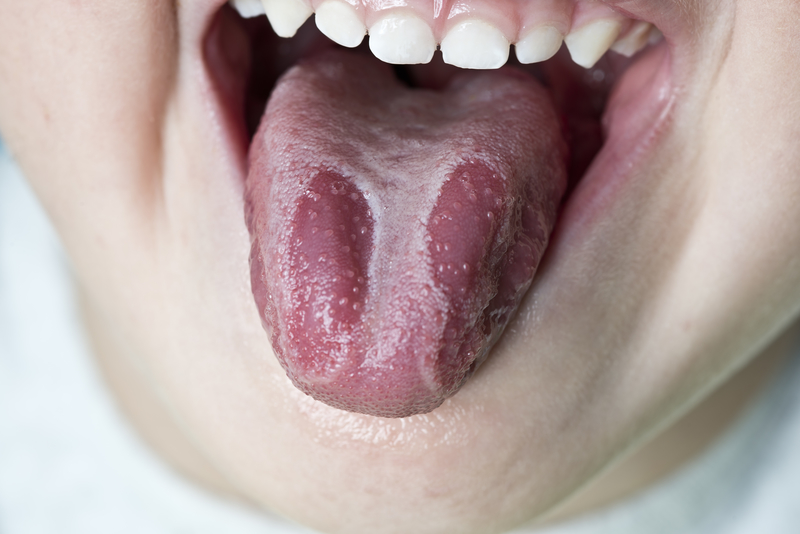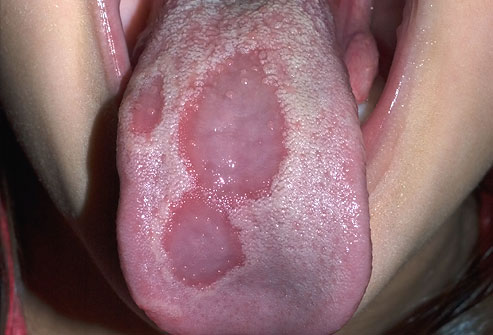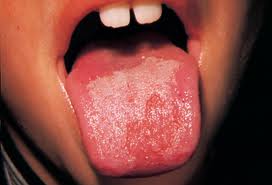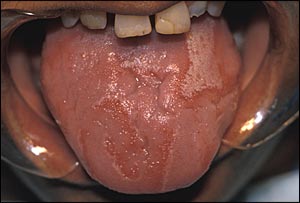Geographic Tongue
Geographic tongue (or "geographical tongue") can look very odd, and when you first notice it, most people tend to panic a bit. That's a normal reaction to something that looks weird, and we are all much more aware these days of the dangers of mouth cancer and tongue cancer. So a lot of folk rush off to the dentist or doctor to get it checked.
 Geographic tongue
Geographic tongueThis is good, because you should always get any odd-looking lump or discoloration in your mouth checked by a health care professional. The earlier a problem is diagnosed, the earlier treatment can start (if needed), and the better the outlook. The longer you leave it, the more difficult treatment may be if you need any. Fortunately, for geographic tongue, treatment is only required if you are having some discomfort. More on that in a minute.
What is geographic tongue? The name is a clue. It can look like a little map of some sort. Geographical tongue is actually a patch (or patches) on your tongue. The shape and size of the patches usually change slowly over a period of time.
Geographic Tongue
Sometimes they change position from day to day. Other times a patch may stay in one spot for a month! The shape also changes, and so does the size. Sometimes the patches may almost disappear completely for a while.


However, there is no cause for alarm.
Geographic tongue is completely harmless.
It is NOT associated in ANY way with mouth cancer nor cancer of the tongue. It is also nothing to do with infection.
If you are concerned about a tumor, please go to my Mouth Cancer Symptoms page for more information.
YOU CAN ALSO compare the appearance of geographical tongue to tongue cancer at Tongue Cancer Pictures. You will see that geographic tongue is completely different. Geographic tongue occurs on the top surface of your tongue, and has a flat, smooth reddish patch.
In contrast, tongue cancers usually occur on the sides of the tongue or under the tongue, and start off looking like a little ulcer. They also stay in one spot, whereas a geographical tongue patch frequently changes shape, size and position over days or weeks.
Geographic Tongue
What causes this appearance?
The surface of your tongue is normally covered with lots of tiny pink bumps, smaller than a pin-head. These are called papillae. With geographic tongue, a whole bunch of these tiny papillae shrink down and disappear, leaving a smooth surface. This patch of smooth surface is frequently a reddish color, and the edges can be raised slightly, and white in color.
No wonder it looks alarming! Red patches on your tongue! AND sometimes the red patches can be a little sensitive to certain things, like strong toothpastes or spicy foods.
While the exact cause of geographic tongue is a mystery, some recent research points to a common ingredient in almost all toothpastes - Sodium Lauryl Sulfate - as an irritating agent. This is basically a type of soap. Toothpaste manufacturers add it to their toothpastes to make them froth up, so that they "feel more effective".
So the ONE big, simple step you can take if you have geographical tongue is to switch to a toothpaste that does not contain Sodium Lauryl Sulfate.
In my opinion as a dentist, the best toothpaste WITHOUT Sodium Lauryl Sulfate comes from TheraBreath.
BUT you have to use the TheraBreath mouthwash too, after brushing, for the best results! I really like TheraBreath products! Have a look at the TheraBreath Oral Rinse
Geographic Tongue
The exact, precise cause of the condition is unknown.
We simply don't know exactly what causes the tiny papillae to shrink, nor why it seems to affect certain people but not others. Women tend to be affected more than men.
 image courtesy of Dr. C. Fowler, DDS
image courtesy of Dr. C. Fowler, DDSThere may be a connection with drinking alcohol or eating very spicy foods, but strangely it seems to occur less frequently in smokers. (But this is NOT a good reason to take up smoking!). There may also be a connection with vitamin B deficiency. Some sufferers have found that avoiding cinnamon and mint in any form seems to help.
My Self-Help Tips:
- Cut down on the amount of alcohol you drink
- Avoid hot spicy foods
- Avoid cinnamon and mint in ALL forms
- Take vitamin supplements, especially vitamin B and Zinc
- Get your dentist to check for any signs of tongue infection
- Keep your tongue clean. Don't use a tongue scraper, but DO brush it gently to remove any surface build up.
The most efficient way of cleaning the surface of your tongue is with a sonic tongue cleaner, like the one that comes with the Cybersonic 3 toothbrush.
This is very gentle but also very efficient.I recommend the Cybersonic 3 sonic toothbrush. I think it has the best performance of any brush I've tested, and you can read more at my page Best Sonic Toothbrush.
TREATMENT options are rather limited.
There is no treatment that is guaranteed to make the patches go away, but there are some treatments to help with the sensitivity or irritability that some people get with this condition.
These treatments are limited to an antihistamine gel or a steroid mouthwash. You normally have to get a prescription for these from a doctor or dentist.
As already stated, some doctors have reported getting good results with vitamin B supplements and also zinc supplements, but on their own they don't seem to be a permanent cure for those people who are prone to getting geographic tongue.
However, following my self-help tips above, AND switching to a toothpaste that does not contain Sodium Lauryl Sulfate (such as TheraBreath) frequently minimizes or even eliminates geographic tongue for long periods at a time!



